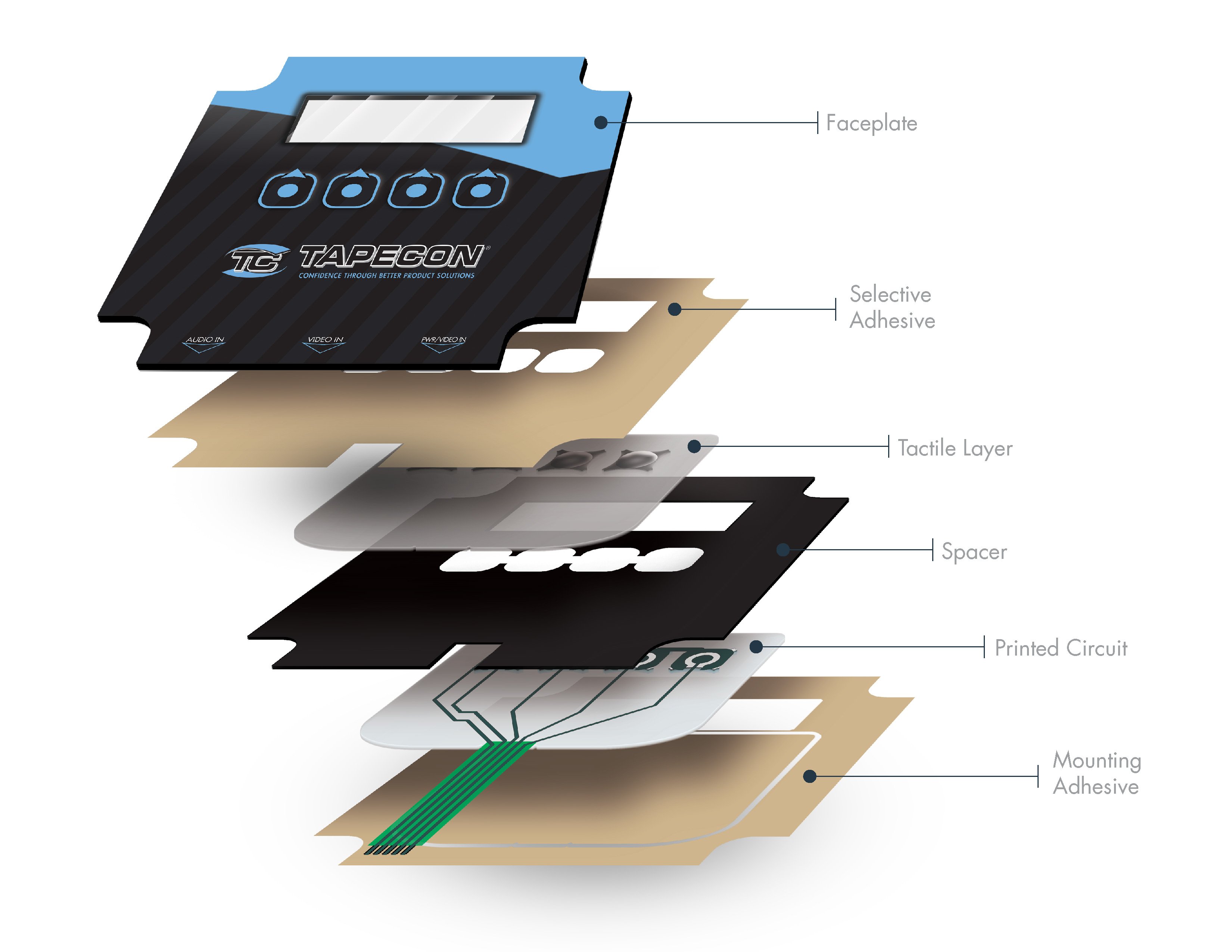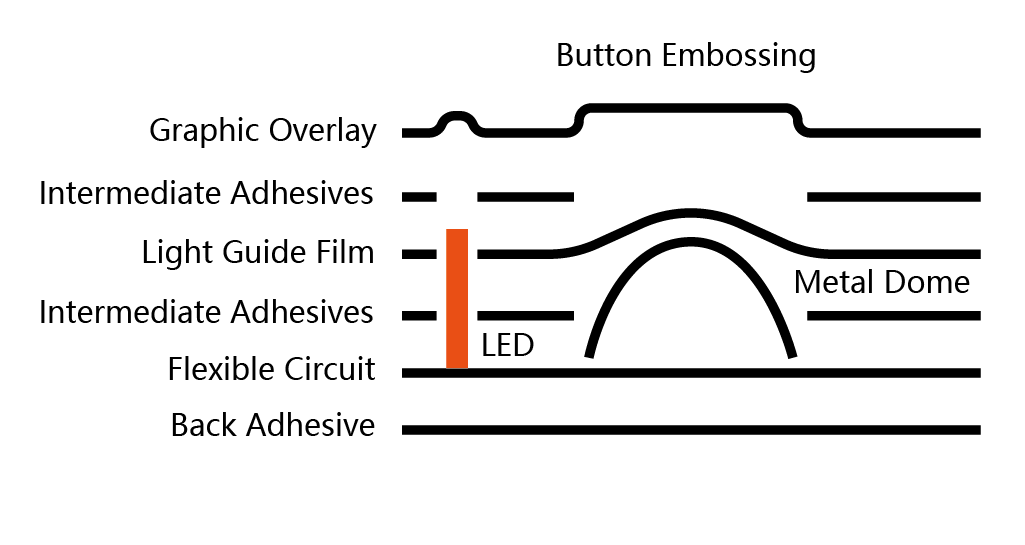Everything About Membrane layer Switch Over: A Comprehensive Overview for Beginners
Membrane buttons are crucial elements in contemporary electronic devices, offering a special interface for customer interaction - membrane switch. Their split building and construction, consisting of overlays and conductive traces, gives capability and longevity. Unlike standard mechanical switches, membrane layer switches provide a streamlined layout and personalized choices. Recognizing their crucial features and benefits can change product style. Nonetheless, the intricacies of their application and style considerations call for additional exploration
What Is a Membrane Switch over?
A membrane button is a sort of electrical switch that is composed of an adaptable membrane layer layered over a published motherboard. This style enables a sleek and small user interface, usually made use of in different electronic gadgets. Membrane layer buttons are typically located in customer devices, clinical equipment, and commercial equipment as a result of their resilience and resistance to ecological factors.The building commonly includes multiple layers, such as visuals overlays and adhesive support, which provide responsive responses and shield the circuitry underneath. The operation of a membrane button is initiated when stress is put on the surface, finishing an electrical circuit.These buttons are valued for their versatility, allowing personalized designs and published graphics that satisfy details individual interfaces. Their low-profile nature decreases space demands, making them excellent for applications where standard switches may not fit. In general, membrane buttons supply a visual and practical option for modern-day electronic devices.
Key Elements of Membrane Switches
Membrane switches over make up several key elements that add to their functionality and efficiency. The top layer, recognized as the overlay, offers the interface and is typically printed with symbols or graphics. Under the overlay exists a spacer layer, which separates the conductive elements and avoids inadvertent activation. The following essential part is the visuals layer, which boosts looks and assures the durability of the design.Conductive traces, usually made from materials like silver or carbon, are printed on the circuit layer. When stress is applied to the overlay, these traces enter contact, finishing the circuit. In addition, a backing layer offers architectural assistance and can be made from products such as polyester or polycarbonate. With each other, these parts develop a trusted, easy to use user interface suitable for various applications, from household devices to industrial tools. Comprehending these components is crucial for any individual thinking about membrane layer switch modern technology.
Just How Membrane Layer Changes Job
Recognizing how membrane switches feature is important for valuing their widespread usage in different devices. A membrane layer switch runs via a series of layers, consisting of a graphic overlay, spacer, and a circuit layer. When pressure is related to the overlay, it presses the spacer layer, enabling the circuit layer to make get in touch with and complete an electric circuit. This activity sends out a signal to the tool, prompting a response, such as activating a light or activating a function.Membrane switches over can be created with various features, including tactile responses, backlighting, and custom-made graphics, improving individual communication. Their construction enables for a covered design, protecting the internal elements from dirt, moisture, and contaminants. This resilience makes them ideal for varied applications, from consumer electronics to commercial devices. In general, the simplicity and performance of membrane layer switches over add to their appeal in modern innovation.
Benefits of Membrane Switches Over Mechanical Buttons
While mechanical switches have actually long been a staple in numerous tools, membrane changes deal unique benefits that make them progressively appealing. One substantial advantage is their slim profile, enabling more small layouts and better flexibility in item advancement. Additionally, membrane layer switches function an uniform surface, which boosts aesthetic appeal and simplifies cleaning, making them suitable for atmospheres where health is critical.Another benefit is their resistance to dust and wetness. Unlike mechanical buttons, which can be endangered by environmental factors, membrane buttons give a covered interface that secures against pollutants - membrane switch. Membrane buttons typically have a longer life-span due to fewer relocating components, resulting in enhanced durability and reliability.Cost-effectiveness is additionally a noteworthy benefit, as membrane buttons can be created in bulk with lower manufacturing expenses. These factors integrate to place membrane buttons as a sensible option to conventional mechanical options in different click here for more applications
Typical Applications of Membrane Switches
Membrane layer switches are extensively utilized in numerous sectors, particularly in customer electronics and commercial control board. In customer gadgets, they offer a sleek, straightforward interface, while in commercial setups, they improve longevity and performance. Recognizing these applications highlights the flexibility and usefulness of membrane buttons in contemporary innovation.
Customer Electronics Tools
As consumer electronic devices remain to advance, membrane buttons have become a popular selection for a range of tools because of their adaptability and streamlined layout. These switches are commonly located in mobile phones, tablets, and push-button controls, where space is limited and aesthetic appeals issue. Their low profile and adjustable designs allow producers to produce straightforward interfaces that enhance the total individual experience. Additionally, membrane layer buttons are typically utilized in devices such as microwaves and coffee machine, offering instinctive control choices while resisting wetness and dirt. The durability and reliability of membrane layer switches over make them suitable for daily customer products, making certain long life and constant efficiency. Overall, their integration in customer electronics shows a mix of capability and modern-day layout.
Industrial Control Panels
The applications of membrane layer switches over expand beyond customer electronics, finding significant use in industrial control panels. These buttons are favored for their toughness and resistance to harsh environments, making them excellent for manufacturing and procedure control setups. They provide a trustworthy interface for drivers to manage equipment, monitor processes, and change setups. Membrane layer buttons can be personalized to fit particular operational requirements, integrating features like backlighting and responsive comments, improving user experience. Their inconspicuous style enables for integration right into various devices, while their capability to endure spills, dust, and severe temperatures guarantees long life. Generally, membrane switches add to safe and reliable operation in industrial applications, demonstrating their versatility and performance sought after atmospheres.
Considerations for Creating Membrane Changes
When creating membrane buttons, picking the best materials is vital to ensure sturdiness and performance. Furthermore, understanding layer configuration strategies can substantially influence the switch's efficiency and customer experience. These factors to consider play an important duty in developing trusted and effective membrane switch designs.
Product Selection Value
Product option plays a vital function in the design and capability of membrane layer buttons. The selected materials directly affect the button's durability, responsive feedback, and total visual. Key considerations consist of the substratum, which need to offer structural integrity while enabling adaptability, and the graphic overlay, which needs to be immune to put on and environmental elements. Conductive products must ensure dependable electrical efficiency, while adhesives should offer solid bonding without compromising the switch's operation. Furthermore, compatibility with making procedures and end-user atmospheres is vital; products should endure differing temperatures, moisture levels, and chemical direct exposure. Eventually, suitable product selection not just enhances the membrane layer switch's efficiency but additionally contributes to its long life and user satisfaction, making it a crucial aspect of the style procedure.

Layer Configuration Methods

Regularly Asked Questions
How Much Time Do Membrane Switches Over Usually Last?
Membrane layer switches normally have a lifespan of 1 to 5 million cycles, depending upon use and environmental problems. Variables such as design high quality and operating see this here regularity significantly affect their view it now durability and general efficiency long life.

Can Membrane Switches Be Customized for Details Layouts?
Membrane switches can without a doubt be tailored to fit particular designs, permitting diverse shapes, shades, and performances. This versatility makes it possible for makers to tailor these buttons to fulfill distinct aesthetic and functional requirements effectively.
What Products Are Utilized in Membrane Layer Change Construction?
Membrane layer buttons are normally constructed utilizing products such as polyester, polycarbonate, and adhesive layers. These products provide sturdiness, resistance, and adaptability to ecological variables, ensuring the switches operate effectively in different applications and problems.
Are Membrane Layer Switches Resistant or water resistant to Dampness?
Membrane layer switches can be designed to be moisture-resistant, using specialized finishes and products. However, their waterproof abilities depend upon building high quality and details applications, making it necessary to assess requirements for perfect performance in different settings.
Exactly How Are Membrane Switches Repaired if Harmed?
Fixing damaged membrane switches commonly entails changing the impacted layer or circuit. Service technicians may likewise apply conductive glue or make use of specialized repair service sets, guaranteeing functionality is restored without full replacement of the entire button assembly. Unlike traditional mechanical buttons, membrane layer switches offer a smooth design and personalized choices. A membrane button is a kind of electrical button that is composed of a flexible membrane layer layered over a published circuit board. The operation of a membrane layer switch is launched when pressure is used to the surface, completing an electric circuit.These buttons are valued for their convenience, making it possible for personalized layouts and published graphics that cater to details individual interfaces. While mechanical buttons have long been a staple in several gadgets, membrane layer changes deal unique benefits that make them progressively appealing. Membrane layer switches typically have a longer life expectancy due to fewer moving components, resulting in enhanced longevity and reliability.Cost-effectiveness is likewise a remarkable benefit, as membrane layer buttons can be created in mass with lower manufacturing prices.